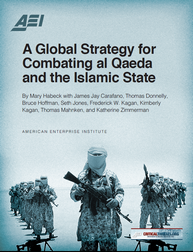{{currentView.title}}
December 07, 2015
A Global Strategy for Combating al Qaeda and the Islamic State
A report by Mary Habeck with James Jay Carafano, Thomas Donnelly, Bruce Hoffman, Seth Jones, Frederick W. Kagan, Kimberly Kagan, Thomas Mahnken, and Katherine Zimmerman
Executive Summary
 The United States faces a fundamental challenge to its way of life. Al Qaeda and the Islamic State (ISIS), two groups that have already killed thousands of Americans and tens of thousands of Muslims, are waging war on the United States, our allies, and our friends as part of a general strategy to create a global caliphate. As evidenced by their gains in Syria, Iraq, Libya, Yemen, and South Asia, the extremists are no longer on the run and arguably are winning. Al Qaeda, in particular, has expanded its control and influence in the past few years, with affiliates and linked groups present in more than 20 countries.
The United States faces a fundamental challenge to its way of life. Al Qaeda and the Islamic State (ISIS), two groups that have already killed thousands of Americans and tens of thousands of Muslims, are waging war on the United States, our allies, and our friends as part of a general strategy to create a global caliphate. As evidenced by their gains in Syria, Iraq, Libya, Yemen, and South Asia, the extremists are no longer on the run and arguably are winning. Al Qaeda, in particular, has expanded its control and influence in the past few years, with affiliates and linked groups present in more than 20 countries.
 |
Whereas these organizations were limited mostly to terrorist activities in 2011, today they are playing leading roles in a dozen active insurgencies and, along with ISIS, are beginning to demonstrate conventional warfare capabilities in places like Syria, Iraq, and Yemen. ISIS, meanwhile, has control of large swaths of territory in Syria and Iraq and is performing all the functions of governance in these areas. Perhaps even more important, the extremists currently have momentum: expanding the territory under their influence, increasing their access to safe havens, spreading their ideology, and raising their capabilities.
In seeking to counter these threats, the United States faces significant strategic challenges. American leaders still have not recognized the nature of this war and have a dangerous misconception of the threat. At the same time, our global position is materially worse than it was just three years ago. We have fewer allies, fewer capable partners, fewer forward bases, fewer available resources, and fewer forces to deal with the threat. The policies the United States has adopted to confront al Qaeda and other extremists are also reactive, rather than proactive, ceding initiative to the extremists. All these developments create the perception that the United States is no longer winning the fight against al Qaeda and ISIS.
Although the ongoing US-led airstrikes in Iraq and Syria demonstrate increased American resolve, the United States needs a new strategy to stop ISIS, al Qaeda, and affiliated groups: a counterinsurgency with ideological, security, diplomatic, economic, and political components. This comprehensive population-centric strategy must confront ISIS and al Qaeda on a regional basis, rather than in independent undertakings. The first effort must focus on the Levant, an area that includes Syria and Iraq, as well as on the Arabian Peninsula, which acts as a crucial support for the extremists’ main fight. Beyond these two areas, the US will also need to engage in South Asia, which provides al Qaeda, in particular, with its main command node.
The objectives of this strategy are clear: al Qaeda, ISIS, and the jihadist or Islamist movements close to the group must be defeated decisively, the territory and people that they control must be freed, and extremist ideology must be so discredited that few Muslims will feel attracted to its arguments. Given the size of the problem, the United States needs capable partners with responsive, legitimate governments to help degrade and defeat ISIS and al Qaeda militarily and ideologically.
For the purposes of this strategy, victory will mean reducing al Qaeda and ISIS back to the original terrorist group that they were in the late 1980s: small and incapable of carrying out mass-casualty terrorist attacks. This can happen only when we have degraded the extremists’ capabilities until they are once again unable to recruit enough followers to replace leaders lost, to hold territory or enforce their version of sharia, and to carry out anything but minor and local terrorist attacks. None of this is possible without capable partners.
The global and comprehensive nature of this counterinsurgency strategy leads to an especially difficult challenge: this will not be an easy or short conflict, and the country must be prepared politically, fiscally, militarily, and mentally for a long war. Given the long-term and continuous effort inherent in this strategy, building domestic support and bipartisan agreement is vital. The risks of action seem clear and overwhelming, but the risks of inaction—including the loss of key terrain to both groups, the creation of multiple safe havens for the extremists to plot against us, and the undermining of states around the globe—are even more dire.
As these conditions worsen, al Qaeda and/or ISIS will carry out a mass-casualty attack against the homeland: it is a question of not if, but rather when. Even more worrisome is our assessment that, if we fail to stop the extremists from taking territory and undermining states, al Qaeda or ISIS will obtain weapons of mass destruction; then it will be too late to act. Preventing these outcomes will require a serious and prolonged effort, but it is an effort that is well worth the costs and risks for the United States and our allies and partners.
